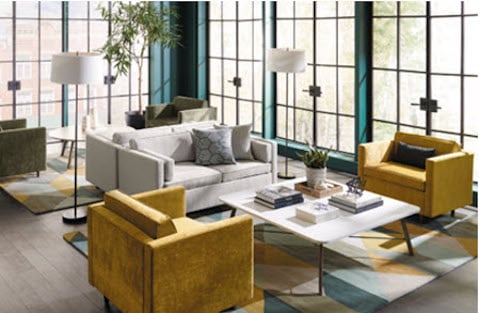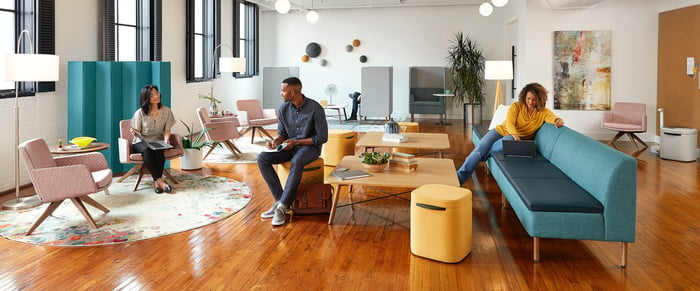Spring fever is officially here for organizations across the country. The sun is shining, change is in the air, and return-to-work plans are in full swing.
As companies welcome back employees, the timing has never been better for a fresh office makeover, starting with your office furniture!
Add this list of considerations to your office space planning strategy and learn more about what office furniture and where to buy it to make the return to "normal" exciting, inspiring and productive.
Office Space Planning Considerations
When designing your office space, you may feel overwhelmed by all of the factors you have to think about, but if you place employee engagement and productivity first, you’re off to a great start.
1. Where Employees Have Been
Many employees were flung into work-from-home situations, which required an adjustment period. A year later, and these employees now find themselves having to readjust to life back at the office.
One way to make the transition less disruptive is to bring elements of home into the office. Consider furnishing break areas with cozy couches, accent tables, decorative lamps, and other elements that will remind employees of the comforts of home (minus the bickering children and restless pets).
2. What Employees Want
Understanding employee preferences and delivering on them can be a powerful bargaining token for employee engagement initiatives.
The challenge is balancing preferences across a diverse, multi-generational workforce. Think about universal elements that appeal to all audiences — for example, a revival of the employee break room.
3. New Employee Needs
While some needs have remained the same, others have changed, and therefore require extra consideration when office space planning.
For example, video chatting is a new trend that office managers can expect to see a lot more. Anticipate employee needs by investing in casual lounge furniture and personal tables.
Panel cubbies offer privacy and a non-distracting backdrop for personal or business-related video calls.
4. Long-Standing Employee Needs
Even the "new normal" won't change certain employee needs, such as ergonomic office furniture. The numerous health and productivity benefits of improved comfort and posture during long work hours are well documented.
Unless free-form levitation becomes a thing, office managers can expect ergonomic chairs and sit-stand workstations to remain a permanent fixture on employee wish lists.
5. Social Distancing
Above all else, office space planning must incorporate more safety into floorplan designs to build employee confidence and trust. The safety features you build into your office design should not prevent employees from interacting, though.
If you need space planning ideas for social distancing and safety, consider workspace dividers and screens. You can also use this checklist to help you return to work safely.
6. Furniture Color
Furniture, including its color, can have a significant impact on the mood and vibe your office gives off to employees.
Bright colors such as reds and yellows can elevate energy levels and stimulate feelings of happiness. Blues and greens are more relaxing and calming.
Define the vibe your company is going for and create a color palette to ensure that the furniture you select reflects the atmosphere you’re trying to create.

7. Workflows
The layout and design of your office environment have everything to do with workflow efficiency.
Depending on the type of work performed, some employee audiences thrive in open spaces that encourage socialization and collaboration. Other employees prefer privacy for deep focus and quiet conversation.
Map out processes that routinely unfold during day-to-day office activity and compare them with your current floorplan.
Streamlining processes could be as simple as moving departments closer together or investing in modular office furniture that allows for different configurations.
8. Office Furniture Installation
The last thing employees want in a fresh new office space is office furniture installation that requires their help or disrupts their workday. This is why working with a full-service office furniture dealer is an important detail to consider.
Full-service dealers assign a project manager to your account to ensure that from planning and ordering to delivery and installation, the entire process runs smoothly for office managers and employees.
9. Cost
Cost is an inevitable consideration when shopping for office furniture, but don't let face value be your deciding factor.
When it comes to furniture, you get what you pay for. In other words, if the product is cheap, so is the performance.
Set a realistic budget for your spring office furniture makeover and consider the return on your investment over several years. Quality furniture is built to last. Over time, cheap furniture may end up costing you more.
Spring Into Action
Start with an assessment of your current office layout and environment. Define how you want the new office environment to look and feel.
Naturally, many of your decisions will focus on the employee experience, but it's also important to consider how office furniture can be used to elicit certain behaviors, such as collaboration, focus and productivity.
Office Basics can help you with your office space planning, design, and installation. Schedule a consultation today.




